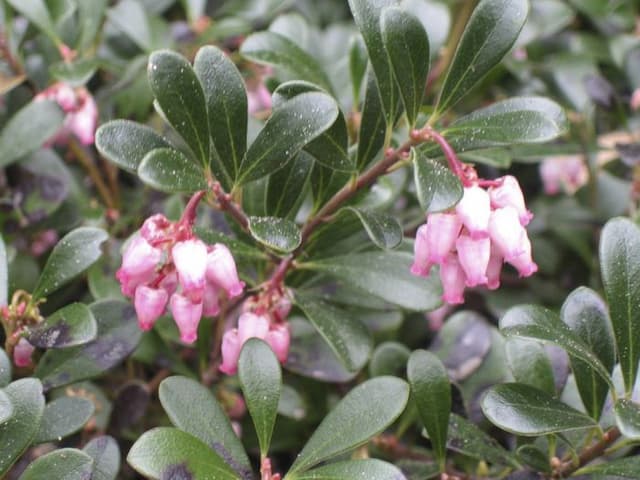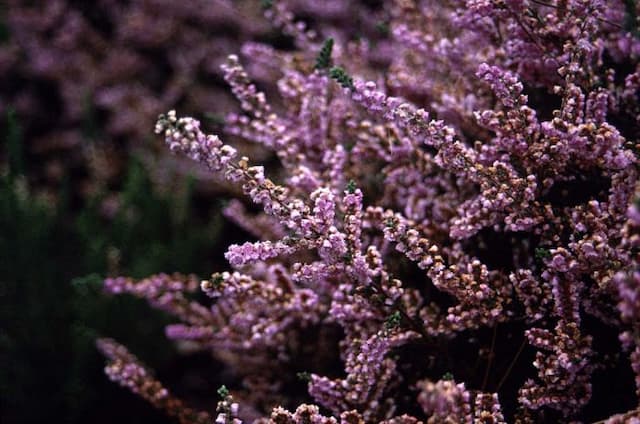Azalea Rhododendron (Obtusum Group) 'Amoenum' (Ea/d)

ABOUT
The 'Amoenum' azalea, belonging to the Rhododendron (Obtusum Group), presents a visually striking appearance. It boasts a profusion of vividly colored flowers, which tend to have a rich, purplish-red hue. These flowers are shaped like trumpets and emerge in a showy, dense cluster, providing an impressive display of color in the garden. The foliage is also an attractive feature of the 'Amoenum' azalea, with leaves that are small, glossy, and dark green. They offer a lush background that contrasts beautifully with the brightness of the flowers, accentuating their vibrancy. The leaves are evergreen, providing year-round interest even when the plant is not in bloom. Overall, the appearance of the 'Amoenum' azalea is characterized by its striking blooms and attractive glossy foliage, which together create a visual spectacle that can be a focal point in any garden setting. The appealing contrast between the flowers and leaves, along with its vivid coloring, makes it a favorite among gardeners who wish to add a splash of color to their landscape.
About this plant
 Names
NamesFamily
Ericaceae
Synonyms
Amoenum Azalea, Hortulanus H. Witte Azalea
Common names
Rhododendron obtusum 'Amoenum', Rhododendron kiusianum x Rhododendron obtusum 'Amoenum', Azalea amoena
 Toxicity
ToxicityTo humans
Azalea is toxic to humans. It contains grayanotoxins, which, upon ingestion, may cause symptoms including nausea, vomiting, weakness, dizziness, difficulty in breathing, and can possibly lead to a drop in blood pressure, coma, or even death in severe cases.
To pets
Azaleas are also toxic to pets, including both dogs and cats. Symptoms of azalea poisoning in pets can involve gastrointestinal upset, such as drooling, vomiting, diarrhea; a change in heart rate; weakness; central nervous system depression; and in severe cases, could lead to coma or death. It is important to seek veterinary attention immediately if azalea ingestion is suspected.
 Characteristics
CharacteristicsLife cycle
Perennials
Foliage type
Evergreen
Color of leaves
Green
Flower color
Red
Height
4 feet (1.2 meters)
Spread
4 feet (1.2 meters)
Plant type
Shrub
Hardiness zones
6
Native area
Japan
Benefits
 General Benefits
General Benefits- Ornamental Value: The Rhododendron 'Amoenum' is prized for its vibrant blooms which add a splash of color to gardens and landscapes.
- Hardiness: It is a relatively hardy plant that can withstand cold temperatures, making it suitable for a variety of climates.
- Low Maintenance: Once established, Rhododendrons require minimal care, making them an ideal choice for both novice and expert gardeners.
- Long Blooming Period: The plant has a long flowering season, providing a display of beauty for an extended period.
- Attracts Wildlife: The flowers attract pollinators such as butterflies and bees, promoting biodiversity.
- Evergreen Foliage: Rhododendrons maintain their leaves throughout the year, offering constant greenery in the landscape.
- Privacy Screen: Due to their dense growing habit, Rhododendrons can be used as a privacy screen or hedge.
- Variety of Uses: They can be planted in mixed borders, woodland gardens, or used as a specimen plant for focal interest.
- Slope Stabilization: Their root systems can help prevent soil erosion on slopes.
- Seasonal Interest: Aside from their flowers, some Rhododendrons offer attractive fall and winter foliage, adding seasonal interest to the garden.
 Medical Properties
Medical PropertiesThis plant is not used for medical purposes.
 Air-purifying Qualities
Air-purifying QualitiesThis plant is not specifically known for air purifying qualities.
 Other Uses
Other Uses- Dye Production: Azalea flowers can be used to produce natural dyes for textiles, imparting soft hues of pink, purple, or red depending on the mordant used.
- Ink Ingredient: The petals can be crushed and mixed with other substances to create inks for art or writing.
- Educational Tool: Azaleas can serve as an educational subject for botanical studies due to their diverse genetics and hybridization possibilities.
- Photography Subject: Due to their vibrant blooms, azaleas are popular subjects for photographers, particularly during springtime.
- Culinary Garnish: In some cultures, azalea flowers are used as an edible decoration for dishes although caution is advised as parts of the plant can be toxic if ingested.
- Fish Poison: Historically, some native tribes used Azaleas to produce a toxin for fishing by throwing the plant into the water to stupefy fish.
- Literary Symbolism: Azaleas are often used in poetry and literature as symbols of temperance, passion, or fragility.
- Craft Material: Dried azalea flowers and branches can be incorporated into crafts such as wreaths or potpourris.
- Soil Indicator: The presence of azaleas in the wild can indicate certain soil conditions, such as acidity, which can be valuable information for ecologists and horticulturists.
- Floral Arrangements: Azaleas can be used in live or dried floral arrangements for their aesthetic appeal and longevity when properly cared for.
Interesting Facts
 Feng Shui
Feng ShuiAzalea is not used in Feng Shui practice.
 Zodiac Sign Compitability
Zodiac Sign CompitabilityAzalea is not used in astrology practice.
 Plant Symbolism
Plant Symbolism- Caution or Danger: Rhododendron is often associated with caution due to the toxic nature of its leaves and nectar, which can be harmful if ingested.
- Beware: Similarly, it's a symbol for bewaring, as in many cultures it is understood that the plant should be approached with care.
- Abundance: The abundant and vibrant blooms of the Rhododendron can symbolize growth, abundance, and prosperity.
- Elegance and Wealth: With its lush, full blossoms and rich foliage, the Rhododendron can represent elegance and the wealth of beauty.
- Rejuvenation: As an evergreen, Rhododendron symbolizes new growth and rejuvenation, highlighting the cycle of life and rebirth.
 Water
WaterAzaleas require consistent moisture, so water the plant with about 1 inch of water per week. During the growing season, especially in dry conditions, it may be necessary to water two to three times weekly. Use a soaker hose or drip irrigation to provide deep watering that encourages root growth without wetting the foliage. Ensure the soil is well-draining to avoid waterlogging. Always allow the top inch of soil to dry out slightly before watering again to prevent root rot.
 Light
LightAzaleas thrive in locations where they can receive partial shade to filtered sunlight. They should be protected from the hot afternoon sun, which can be too intense, so an area with morning sunlight and afternoon shade is ideal. These plants can also do well in dappled light beneath the canopy of loosely branched trees or in the shadow of a building.
 Temperature
TemperatureAzaleas are hardy and can tolerate a range of temperatures but prefer an environment between 50°F and 80°F for optimal growth. They can survive minimum winter temperatures down to about 20°F. Extended periods of heat above 90°F may stress the plants, so provide adequate shade and moisture during the hot months.
 Pruning
PruningAzaleas should be pruned for shaping, size control, and removal of dead or diseased wood. The best time to prune is just after the blossoms have faded in the spring to avoid cutting off next year's buds. Lightly trim the plant to maintain its natural form, removing no more than one-third of the branches each year.
 Cleaning
CleaningAs needed
 Soil
SoilAzaleas, including Rhododendron 'Amoenum', thrive in acidic soil with a pH of 4.5 to 6.0. A good mix would be a combination of peat moss, pine bark, and perlite in equal parts to ensure good drainage and aeration. It's essential to avoid lime and reduce high pH levels as they dislike alkaline conditions.
 Repotting
RepottingAzaleas like Rhododendron 'Amoenum' should generally be repotted every 2 to 3 years. It is best to repot in the late winter or early spring, as the plants are coming out of dormancy and before they put on significant new growth.
 Humidity & Misting
Humidity & MistingAzaleas require moderately high humidity levels to thrive; aim for a humidity range of 50-60%. A pebble tray with water or a humidifier nearby can help maintain these conditions in an indoor setting.
 Suitable locations
Suitable locationsIndoor
Keep in bright, indirect light and cool temps.
Outdoor
Partial shade, sheltered from wind, well-draining acidic soil.
Hardiness zone
6-9 USDA
 Life cycle
Life cycleThe Azalea 'Amoenum' begins its life cycle with seed germination, typically occurring in a moist, well-drained substrate, with the first stage of growth featuring emergent cotyledons and a radicle. The seedling stage follows, where true leaves develop and the plant begins photosynthesis, setting the foundation for future growth. As it enters the vegetative stage, the azalea grows in size, branches, and establishes a more extensive root system while preparing for the flowering stage. The reproductive stage features the development of vibrant flowers, which attract pollinators for sexual reproduction, leading to the production of seeds. Once pollinated, the plant produces seed capsules, which eventually release seeds, completing the cycle. After several years, the azalea reaches maturity and may continue to flower annually, balancing growth with reproductive output.
 Propogation
PropogationPropogation time
Spring-Early Summer
The most popular method for propagating the Azalea, Rhododendron (Obtusum Group) 'Amoenum,' is by semi-hardwood cuttings. This technique is usually performed in the late summer, after new growth has begun to mature and harden slightly. Cuttings should be about 4 to 6 inches long and contain several sets of leaves. The lower leaves are removed and the cut end is often dipped in rooting hormone before being placed in a mix of peat and perlite or sand. The cutting should be kept moist and out of direct sunlight until roots have developed, a process that can take several weeks to a few months depending on conditions.









